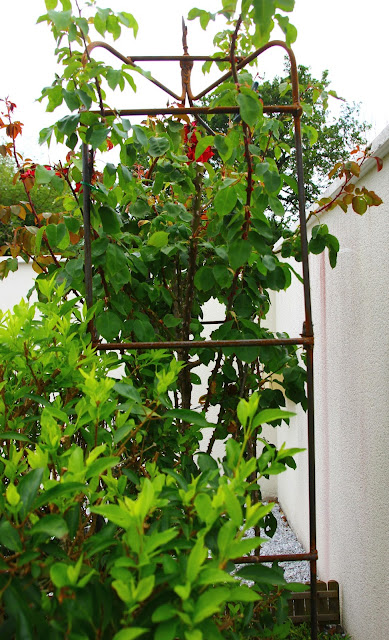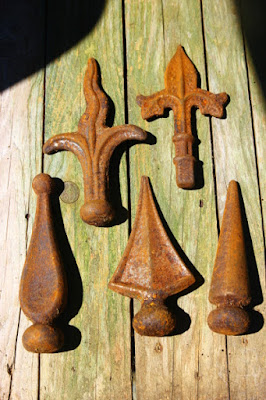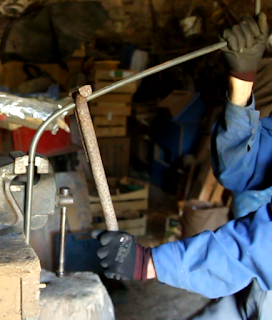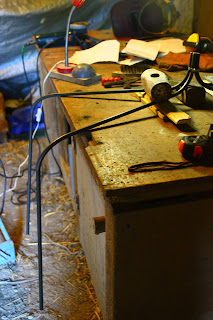All gardens look more interesting with decorative features in them whether they are supporting plants or providing shelters or windbreaks for plants and humans. They can be made from a variety of materials depending on their function, but normally they are fabricated from wood (such as for fences, trellis and arches) or metal, either tube or solid bar. Arches naturally suggest an entrance or continuation and look particularly quirky and intriguing when they are up against an exterior wall like this one. You instinctively feel there must be a secret doorway - if only you could find it.
Wood structures are great and can be readily fabricated often from my favourite material recuperated pallet wood (links below). The disadvantage with wood is often that its lifespan can be relatively short and if it is supporting a plant, repair or replacement could result in damaging the plant. Furthermore, I often find that wooden structures can appear too cumbersome for their duty and this detracts from the elegance and beauty of the plants they are meant to be supporting. It is for this reason that I like to see metal structures in the garden landscape, or as is often the case you do not see them because of their finer structure.
I've made several arches and one aviary from welded metal bar and can testify to the durability of this material and to how they contribute to the architecture of the garden without being too obtrusive. Left unpainted, the metal arches develop a patina of oxide which I find tasteful and blends well with the verdure.

I recently got asked to make an arch for a friend whose original rose arch had fallen apart.
These are the stages I undertook to make the replacement.
Design
 My arches invariably comprise two sides embedded into the ground each side looks like an ethereal ladder, horizontal 'rungs' welded to two uprights. To join these sides and form the arch shape, I attach the top with bolts to the vertical ladders. I make the arch shape by bending four identically shaped sections which when joined at the centre of the structure form the shape of a Tudor arch. To decorate the highest point of the arch I like to have a finial as the finishing touch to emphasize the structure's shape. Image thanks to the British Library 15th Century Pseudo-Heloise, Poems; Art d'amour.
My arches invariably comprise two sides embedded into the ground each side looks like an ethereal ladder, horizontal 'rungs' welded to two uprights. To join these sides and form the arch shape, I attach the top with bolts to the vertical ladders. I make the arch shape by bending four identically shaped sections which when joined at the centre of the structure form the shape of a Tudor arch. To decorate the highest point of the arch I like to have a finial as the finishing touch to emphasize the structure's shape. Image thanks to the British Library 15th Century Pseudo-Heloise, Poems; Art d'amour. The free ends at the bottom of the arch are embedded in the ground, I normally create a guide hole for each free end with the pointed end of a heavy crowbar. Each side of the arch is brought into position so that the free ends are in the holes and they are then forced deeper into the ground by pushing down with the foot onto the lowest horizontal 'rung'. With this particular arch I knew that the soil was pretty free of any obstructions like stones or buried broken tiles but if I thought otherwise I would grind the free ends to a point to aid the insertion.
The required dimensions for the rose arch in this project were: Height 1800mm (71"), width 400mm (16") span 1100mm (44"). The height was to be the above ground height, a further 400mm (16") would be pushed into the ground . I decided to make the uprights 1600mm (63") long, the balance of the required height to be that of the arch section.
A Foreword About Materials
I cut the 8 brackets for joining the sections together from steel angle 25mm x 25mm x 3mm (1"x1"x ⅛").
The embellishment at the top was made up of two items taken from a selection of cast metal decorative finials I had purchased some years ago from Sharratts in Leigh, Lancashire. One was a round ball (not shown) and the other a fleur de lis.
I think the addition of a finial, makes for an aesthetically-pleasing and 'finished' look to the project. To me, it turns something made from very cheap and basic metal sections into something much more decorative.
Fabrication
Arch - Sides
I cut and welded together the components that made up the two 'ladders'. The first (lowest) bottom rung of the ladder was 40 cm from the ladder bottom. the protruding ends were to be pushed into the ground. When both sides were completed, I cut eight short lengths of angle, one face of each angle was drilled to accommodate a 8mm bolt.
Each angle bracket was welded to the top of the 'ladder ends'. The four remaining angle brackets were welded to the ends of the arch top 'legs'. This was to facilitate the assembly of the arch, in particular in this case because it needed to be transported and didn't fit in the car as a whole item! However the ladder and top can be made in one piece but it makes for an unnecessarily difficult time bending something so unwieldy!
Arch - Top
As the design requires no complicated curves, there is no need to make any bending forms for the top section. The curve is simply made by my use of a home-made bending fixture. Use a 1m or a 3' length of 'I' section rolled steel joist, at one end of which, is welded a short piece of angled steel across the width. this acts as the fulcrum when bending.
In addition to the bending fixture, I also fabricated a bending key. I made this from an old piece of wrought iron bar. (see above and below left).
The four lengths of bar were bent at one end (the apex) using the key and fixture.
The other end (the downward leg) of each was bent with the length clamped in a bench vice. I did this because I had better leverage for this bend by using the mass of the work bench to hold the bar.
I bent the first bar until I was happy with the overall look, i.e. for my Tudor Arch design, the rest were then bent to match. I found it was easy to get the feel for the rest after doing the initial length, so each only required minor 'tweaking' after I had compared them with the original.
Before welding the the four elements of the top of the arch together, a collar of metal (a jubilee clip of the appropriate diameter) was used to temporarily secure the joint prior to welding.
The downward legs of the Arch top hung over the sides of the workbench and I also supported the top with some metal blocks. This held everything securely, whilst I was welding.
The finial was a composite, namely a fence rail end fleur de lis and a ball. I welded them together as the ball gave the fleur de lis more dramatic emphasis in the design.
I then welded the completed finial to the top.
The remaining four drilled pieces of angle were welded to the lower ends
of the arch top legs such that the holes were coincident with those on
the ladder section.
Putting it all Together
On a stormy day, the arch has a wonderful Gothic look!
If
you have enjoyed this article and found it interesting then share it
with your friends on social media or suchlike. Please also feel free to
ask questions and or make comments and if you found this helpful and would like to support this site you can always  = $3.
= $3.
Cheers, Andy
© Andy Colley 2020
 The
trellis back to the planter provides a structure up which climbing
plants could grow and provide us with more space for growing food...read more
The
trellis back to the planter provides a structure up which climbing
plants could grow and provide us with more space for growing food...read more
There will be a film coming shortly. Until next time and from a sunny day in Normandie,
Cheers, Andy
© Andy Colley 2020
RELATED ARTICLES
 Pallet Wood Garden Gazebo Part 1 - Posts & Framework
Pallet Wood Garden Gazebo Part 1 - Posts & Framework
We want to spend as much leisure time in the garden as possible. Much as
we love our poultry we do draw the line with sharing our meals with
them...read more
 Pallet Wood Garden Gazebo Part 2 - Trellis and Door
Pallet Wood Garden Gazebo Part 2 - Trellis and Door
The perimeter of the garden gazebo now being complete, the next stage was to make it chicken proof, starting with the door...read more
Untreated Pallet Wood Garden/Beach/Picnic Table & Seat Set for $2
Portable, elegant set
from pallet wood comprising two stools and a picnic table. The design can be made from just one untreated pallet. ...read more
Make Your Own Indoor Trellis Planter Part 1 -The Base
Many people complain that pallet wood isn't a suitable material for use in anything but rough and ready...read more
Make Your Own Indoor Trellis Planter-Part 2 -The Trellis
 The
trellis back to the planter provides a structure up which climbing
plants could grow and provide us with more space for growing food...read more
The
trellis back to the planter provides a structure up which climbing
plants could grow and provide us with more space for growing food...read moreSimple and Elegant Hanging Wall Planter from Orange Box and Pallet Wood
These planters are very easy to make with hand tools, look stylish, can
be finished with earth pigments to suit your colour scheme and despite
their delicate appearance are robust and long lasting....read more






















No comments:
Post a Comment